
The 10 best sea fishing baits and when to use them
You finally have the time to go on your well deserved sea fishing trip. The conditions are right, you’ve got your gear sorted. So what sea fishing bait should you take? I know a lot of anglers who would answer this question with ‘anything I can lay my hands on’. After waiting for so long to go fishing you don’t want to risk not bringing the right, or not enough bait. While I understand the ‘better safe than sorry’ approach, there’s only so much bait you can go through in a session. There’s nothing worse than having to throw away big quantities of expensive bait. So what bait should you bring and when? Below are the 10 baits I most often use, each with their pros and cons.
1. Peeler crab
Where I live, this is probably the deadliest sea fishing bait during most of the season. Cod love peeler crabs, especially during the warmer months. When you’re after red summer cod nothing beats peelers. Bass love peeler crab too, and so do wrasse, flounder, eels, smooth hounds and rays. The scent trail a peeler crab leaves can attract fish from miles away.
What is a peeler crab?
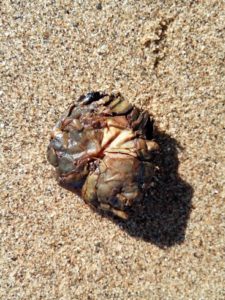
Basically a peeler crab can be any type of crab in the stage of ‘peeling’: losing its old shell to form a new one. Because peeling crab are so vulnerable they tend to look for shelter while shedding their old shell. To collect peelers you have to find out where they hide. For more info on collecting and recognising peeler crabs, I found this video quite helpful.
Pros
- Probably the best bait during the warmer months.
- Not as ‘messy’ as other baits. It doesn’t leave stains or smells on your hands.
- Relatively crab safe. While fish baits can be stripped in minutes, crabs tend to leave peeler crab baits alone most of the time.
Cons
- Expensive. Because it takes a lot of time and effort to collect peeler crab they cost well over a pound each. Of course you can collect them yourself, but it can take quite a bit of time to collect enough for a session. Time you could have spent fishing. You can buy frozen peeler crab online too.
- While peelers are a great bait for a lot of species, they don’t work that well for sight hunters like mackerel or pollock. So in some scenarios it could limit your possibilities. For example bluey (see number 2) will catch you both pollock, mackerel and cod.
- Limited availability. Unless you keep a supply in your freezer, fresh peelers are only available during certain times of the year.
2. Bluey
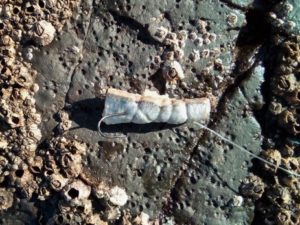
Bluey is my favourite all round sea fishing bait. Also known as pacific saury and mackerel pike (if you look at them you see why), bluey catches almost every sea fish. Because of its high oil content it leaves a very long scent trail. If you can only take one bait and you’re not sure which species will be around, bluey is probably your best bet.
Pros
- Catches a vast range of species, from big winter cod to mini species.
- High oil content. Bluey leaves a big scent trail and doesn’t ‘wash out’ as quickly as other baits.
- Perfect shape and texture. Other oily fish such as herring or sardine are often way too soft to use as bait, especially thawed. Bluey remains firm even after being in and out of the freezer several times. Its cylindrical, eel-like body shape makes it also very aero-dynamic. It’s versatile too. You can use a whole or half bluey for species like conger, or strips of it for mackerel or flounder. A whole fillet, pennel hooked, is a killer for big cod.
- Bluey keeps well in the freezer, especially when vacuum packed. So if you stock up well you will always have a supply ready when you need it. Most tackle shops will stock bluey. Chinese supermarkets often stock bluey too. Just be aware that it will be sold as ‘Pacific Saury’, as bluey is more of an anglers’ nickname for it. If you don’t have a tackle shop or Chinese supermarket in your area, you can also buy bluey online.
- Relatively cheap. Coming down to roughly two pound a fish – 15+ smaller baits – bluey is much cheaper than other sea fishing baits.

Cons
- You can’t catch your own bluey. Unless you live near the north pacific, you will have to buy your bluey frozen. This means the environmental impact will be bigger than when you use bait you caught or collected yourself. As far as I understand bluey are caught close to the surface, using lights to attract them, so at least no bottom trawling involved.
- Unfortunately bluey doesn’t just leave a strong scent trail underwater. It takes some time and effort to get the smell off your hands and clothes.
- Crabs love bluey too. In my experience, crabs love bluey more than anything. So if you’re bottom fishing make sure to check your bait regularly.
3. Lugworm

Lugworm is a great sea fishing bait. In my neck of the woods it’s certainly the best bait for winter cod. Bass love lugworm too; and so do flounder, dab, wrasse. In fact, there are very few species that would say no to a juicy lugworm. For more info on digging and storing lugworm, read this post.
Pros
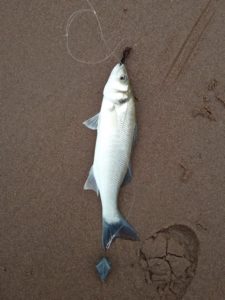
- You can dig lugworm around the whole year (although it’s considerably tougher in winter).
- Very versatile bait. You can use sections of lugworm for flounder or dab or several whole worms for cod. It works very well combined with other baits too, like in a lug and squid sausage.
- Black lugworm can be bought frozen in many tackle shops. Although not ideal, I have caught plenty of fish on frozen blow lug too.
Cons

- It’s soft. Because lugworm is such a soft bait, crabs can clean your hooks in no time. For that reason it’s a good idea to pair lugworm with a tougher bait, like squid to make sure you’re not fishing with empty hooks. To protect worm baits during the cast, it’s a good idea to use an impact shield.
- Keeping lugworm fresh takes a bit of time and effort. Not a very good bait to leave in your car on a hot summer day. Nothing smells worse than decomposing lugworm.
- Lugworm contains iodine and that can leave stains on your hands. The stains are yellow at first but will go black after a while. It comes off with a nail brush and some washing up liquid, but you have to scrub it properly.
- When you can’t dig your own, availability can be a problem, especially during the winter months. It’s a good idea to keep some frozen (black) lug in the freezer, for emergencies.
4. Mackerel

Fresh mackerel is one of my favourite sea fishing baits. I feel fully confident using freshly caught mackerel for a range of species. Whether float fishing for mackerel or pollock, or bottom fishing for flatfish or cod – fresh mackerel does the job. After it has been frozen, it does lose some of its appeal. I’ll happily use frozen and thawed mackerel on the beaches fishing for flounder and turbot, but I wouldn’t use it for cod or pollock unless I don’t have any other option. I tested bluey against frozen mackerel several times on rocky ground, and bluey out-fished mackerel every time. On the beaches I rarely noticed any difference. I guess that has to do with fish being used to scavenge on whatever the incoming tide uncovers. Sometimes these ‘leftovers’ have been rotting in the sun for hours.
Pros

- You can catch your own fairly easily.
- Great all-round sea fishing bait, especially when fresh. Apart from wrasse, most species seem to love fresh mackerel.
- Mackerel is a great bait for flatfish, including turbot.
- Widely available. If you can’t catch your own, fishmongers and bigger supermarkets always stock mackerel.
Cons
- Mackerel goes off quite quickly, so it has to be kept cold.
- Not as effective after it has been frozen (except when beach fishing for flatties).
5. Ragworm
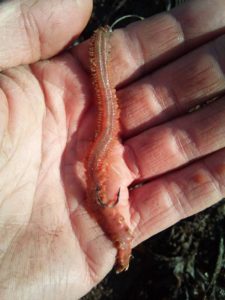
There are days when ragworm out-fishes everything else. It works on all kinds of ground too. Whether beach fishing for flatties or float fishing over rough ground for pollock and wrasse, ragworm is a great sea fishing bait. Because ragworms are relatively thin, you can get away with using smaller hooks (which can increase your catch rate dramatically when fishing for flounder or dab). Unlike lugworms, ragworms keep wriggling on the hook, which make them visually more attractive. There are different species of ragworm. The common ragworm is the one most stocked by tackle shops.
Pros
- Great for flounder and dabs.
- Good float fishing bait for pollock and wrasse.
- You can dig your own bait.
- Widely available. Most tackle shops stock ragworm.
- Visually attractive. For fish.
Cons
- A bit of a flimsy bait. Unless you’re using king or white ragworm, you’ll need to use quite a few to create a decent bait for bigger fish.
- Only keeps for a few days in the fridge, so there is no point in digging or buying huge quantities.
6. Sprats
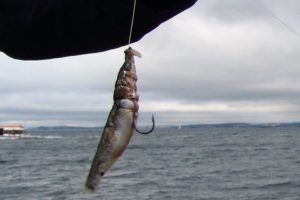
Sprats are my favourite float fishing bait. You can either catch your own with a bait fish drop net or sabiki feathers or buy them frozen at the fishmongers.
Pros
- Visually attractive. Again, mostly for fish.
- Cheap. A 1lb bag costs about £3 and will last you a long time.
- You can catch your own.
- Keeps well in the freezer. Just take as much out as you need and nothing goes to waste. It can also be refrozen without losing too much in quality.
- Very good float fishing bait for mackerel and pollock.
- Very good free lining bait. Just drop a sprat into the current and wait for a pollock to attack it.
Cons
- Doesn’t leave as much as of a scent trail as other baits, so not so good for bottom fishing.
- Relatively soft, so you need to secure it onto your hook with bait elastic. They also don’t survive attacks very well, so if you miss a bite you’re often stuck with just a head on your hook.
7. Sandeels

Sandeels are a common food source for all kinds of marine life. Unfortunately due to overfishing (ground sandeels are often processed into fish feed for fish farms), sandeel stocks have been low the last few years, resulting in a decline in sea birds like puffins and kittiwakes. This obviously has an influence on other fish stocks too. Fish follow the sandeels, so if sandeel numbers are low in a certain area the fishing will be poor as a result. For example, some rock marks might provide great pollock fishing when the sandeels are around, but when they’re not, catches are few and far between.
Live sandeels are a great sea fishing bait. Fished under a float, they’re a killer bait for pollock and bass. Sandeels can be frozen and used as a bottom fishing bait too. Given the choice though I would still use bluey or fresh mackerel over (thawed) sandeel.
Pros
- You can collect your own sandeel. Although it might take a lot of effort, you can dig up sandeel buried in the sand at low tide.
- Great live bait, especially fished under a float.
- Keeps well frozen.
- High oil content.
Cons
- More expensive than baits like bluey.
- Unless used live, not necessarily better than other oily fish baits.
- Quite soft, so it needs to be wrapped to the hook with bait elastic.
8. Prawns
Prawns are a natural food source for loads of sea fish. Live, frozen or even cooked prawns can catch you all kinds of species.
Pros
- You can collect your own by pushing a shrimp net through the sand (or get your kids to do it). You can also catch them in rock pools with a small net.
- Widely available. You can buy shrimps and prawns in one form or another in most supermarkets.
- Live shrimp are a great sea fishing bait, especially fished under a float.
Cons
- Shrimps and prawns don’t leave as long a scent trail as other sea fishing baits, like peeler crab. Not the first bait I would choose when bottom fishing.
- Relatively soft, especially when thawed, so best secured with bait elastic.
- Expensive. Bigger, uncooked prawns, can be expensive. For the money there are a lot better sea fishing baits out there.
9. Squid
Squid is a great sea fishing bait. It’s tough, it’s widely available and it catches loads of species. Squid is a very good winter cod bait either on it’s own or paired with lugworm. Squid is also very good for tipping off other baits, to make sure there’s still something on your hook if everything else is stripped by whiting or crabs.
Pros
- Widely available.
- Great cocktail bait.
- Tough
- Affordable. Selling for around £4-5 a pound, squid is a lot more affordable than other baits.
- You can catch your own, using special squid jigs. Although not as straight forward as catching your own mackerel, people have been successfully targetting squid in the south of the UK.
- Keeps well frozen.
Cons
- Squid can go off quickly so is best kept cold.
- Not the best all-round bait. If you can only take 1 bait, you’re probably better of using something else. It’s an ideal ‘extra’ bait, to add a bit of attraction to other baits.
10. Mussels
Mussels are an underrated sea fishing bait. It might be not be the best all-round bait but it can work miracles in certain conditions and marks. Like squid, it’s one of those baits that works best in a cocktail. Combined with peeler crab it can out-fish anything else on some winter rock marks. For more info on how to collect and prepare mussels for bait, I found this article quite useful.
Pros
- You can collect your own bait at low tide.
- Widely available in supermarkets and fishmongers.
- Freezes well.
Cons
- Preparing mussels for the hook can be a bit of a hassle.
- Soft. Mussel meat is fairly soft, so tying them to the hook with bait elastic is essential.
- Not the best all-round bait.
Other sea fishing bait tips
Keep it cool
To keep your bait in the best possible nick, it’s important to keep it cooled. To keep small amounts of frozen peelers or mussels, a food flask works really well. I can recommend this one. Take it out just before you put it on the hook. That way your bait remains firm and fresh and any leftover bait can go back in the freezer still partly frozen.
For worms and larger amount of fish baits, a cool box is the best solution. If you can, always make sure you store your bait in the shade.
Always carry some spare bait elastic
Bait elastic is essential when it comes to securing most of these sea fishing baits to the hook. Make sure you always have a spare spool in your tackle box or coat pocket. Casting soft baits like mussels without bait elastic is near impossible. The same is true for baits like peeler crab. With other baits it can be useful to help prevent the bait from sliding down the hook and covering the hook point.
Conclusion
Of course there are loads more sea fishing baits out there. I tried to keep this list as ‘all-round’ as possible. Limpets or small live crabs can be great for wrasse, but not very good when after other species for example. Herring is not a bad bait, but bluey is much easier to handle. Cart is a bait that some cod anglers are lyrical about, but I can’t say much about it because I have never used it. (Once I have I might publish my findings here.)
Availability and cost are always an issue of course. Peeler crab might be the best bait out there but who has the time or money to use this bait all the time? Mackerel and lugworm are baits you can easily source yourself and take very little preparation. As I mentioned earlier, from all these baits, bluey is probably the best all-rounder.
What’s your favourite sea fishing bait? Please share your sea fishing bait experiences in the comment section below!
And if you’d like to receive an email every time I publish a new post, please subscribe to my newsletter. Tight lines!
Disclosure: if you purchase anything using the links in this blog post, I might make a commission. Affiliate programs and affiliations include, but are not limited to, the eBay Partner Network. It doesn’t cost you a penny more to buy via these affiliate links (and you don’t have to use them of course) but it helps me to keep this blog going. Thanks!
2 thoughts on “The 10 best sea fishing baits and when to use them”
I like the way you put it in a nutshell, peeler or bluey with fresh mackerel if you can get it ?
I agree fully but I can suggest a good lock down back up which works for dabs and whiting and that is kipper fillet (in the supermarket) make sure you salt heavily to toughen it the day before you want to use it.. When bait is scarce which it is in lockdown? give it a try your be surprised how well it works. Any leftovers go well in an omelette though a bit salty.
Tight lines
Chris
Suffolk
Excellent tip! I’ll definitely give it a go. Tight lines!